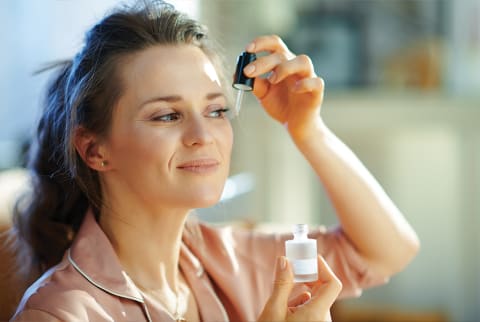Advertisement
Why You Should Use A Blend Of AHAs, BHAs & PHAs, From A Derm


If you're going to invest in high-quality skin care products, you should make sure you get the most out of them, no? A few ways to do so include storing formulas in a temperature-stable environment, keeping jar lids closed tight, and using them at the best cadence for your skin.
Exfoliating acids are no exception. Board-certified dermatologist Whitney Bowe, M.D., shared a noteworthy tip on her TikTok page explaining how to maximize the benefits you get from your chemical exfoliation products.
Why you should use a blend of chemical exfoliants
Bowe shares a quippy nickname for the trio of exfoliating acids: "ABPs," referring to AHAs, BHAs, and PHAs. First up, we have AHAs1, or alpha-hydroxy acids. These hydrophilic (read: water-loving) plant-derived acids help to slough off dead skin cells, brighten complexion, even tone, and encourage healthy skin aging. Simultaneously, AHAs hydrate the skin, which is why they're often recommended for those with sensitive skin. A few common AHAs include:
- Lactic acid
- Glycolic acid
- Citric acid
- Mandelic acid
Next, we have BHAs2, or beta-hydroxy acids. These chemicals are lipophilic, meaning oil- and fat-loving. Thanks to that property, BHAs are especially beneficial for those with oily or acne-prone skin. They're also anti-inflammatory and may help control sebum production. The most common BHA is salicylic acid, well-known for its ability to reduce breakouts.
Finally, we have PHAs, formally called poly-hydroxy acids. These gentle acids help to buff away dead skin cells leading to smoother, brighter skin. A few common PHAs, according to Bowe, include lactobionic acid and gluconolacctone.
So how do you use these chemical exfoliants to maximize their benefits? "In my opinion, you really want a blend of all three if you want to get the most comprehensive, most effective form of exfoliation," Bowe explains.
See, AHAs like glycolic acid have smaller molecules, which means they penetrate deep into the skin; BHAs like salicylic acid dive into the pores; and the PHAs finish off the process by gently exfoliating the epidermal surface and add a boost of hydration.
This doesn't mean you should layer potent serum after serum (that's a recipe for irritation). Instead, look for a product with a pre-formulated blend of all three. This way, you're not left experimenting like a chemist in your bathroom. Here's our top pick:
The takeaway
If you want to get the most out of your exfoliating serums, Bowe recommends using a blend of AHAs, BHAs, and PHAs for all-around benefits. This will contribute to smoother, less congested, and brighter skin.
Essentially, a three-in-one exfoliator is a dream come true on exfoliation nights, assuming you can tolerate acids at all. And remember: You shouldn't use these products every day. Instead, opt for once or twice a week and never mix with retinoids.
